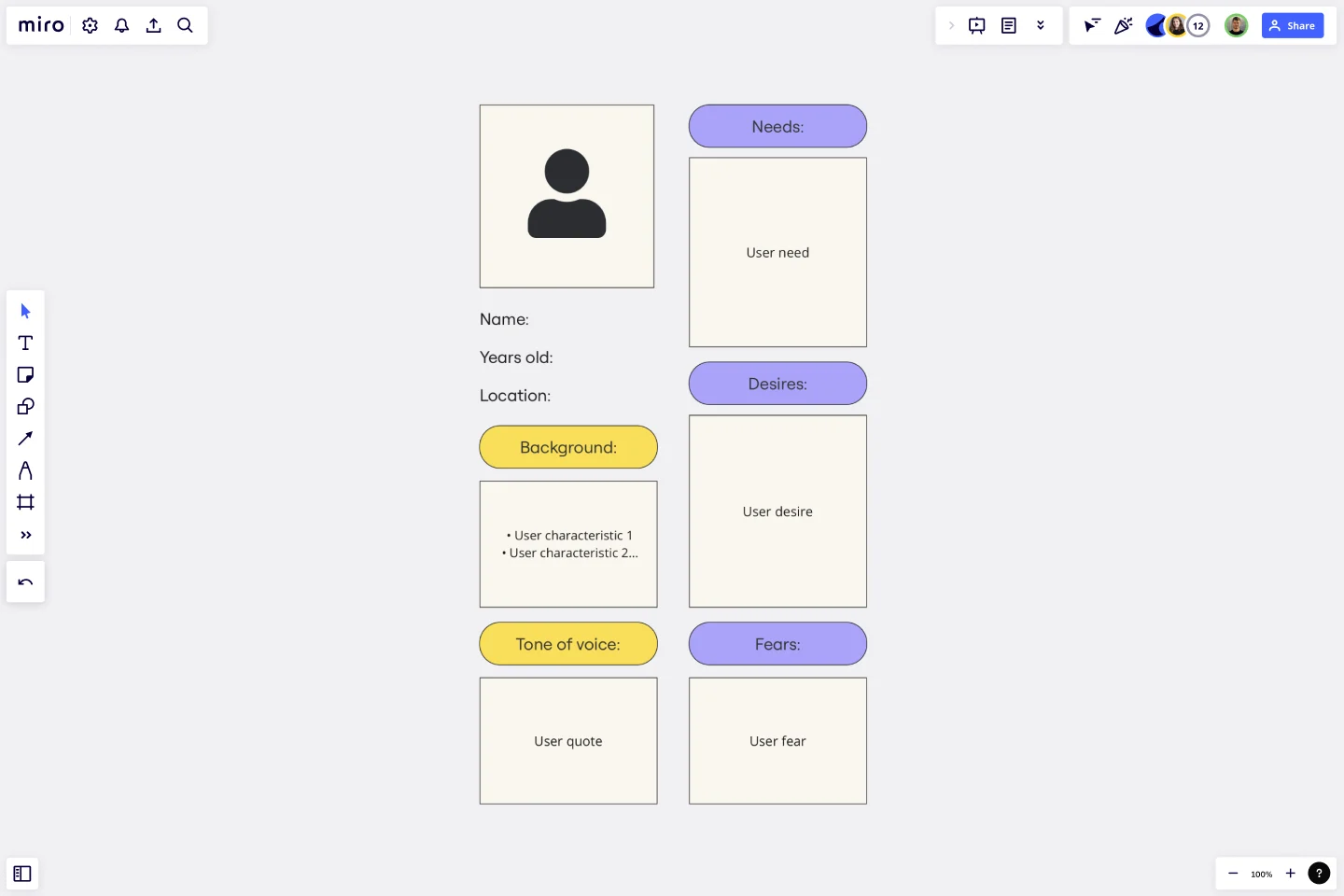Proto Persona Template
Tap into your target audience and foster empathy with the Proto Persona Template. Ensuring resonant solutions for design and strategy teams is now much easier.
Trusted by 65M+ users and leading companies
About the Proto Persona Template
In today's digital landscape, the importance of user-centric design cannot be overstated. The Proto Persona Template offers a structured canvas to sketch out potential user segments, channeling the power of empathy and design thinking to ensure products and services resonate with their intended audiences.
What's a Proto Persona Template?
A proto-persona template is a visual tool crafted to represent and summarize the fundamental characteristics of a hypothetical user or customer. This lightweight, intuitive template outlines a user's presumed needs, behaviors, pain points, goals, and other attributes. It stands distinct from a full-fledged persona template, typically based on comprehensive user research and data. In contrast, a proto persona is based on educated assumptions and serves as a preliminary sketch, setting the stage for deeper user insights in later project phases.
Why should you use a Proto Persona Template?
Understanding and anticipating user needs is important in a world driven by user experience. The Proto Persona Template bridges the gap between initial design concepts and user-centric solutions, offering many advantages for teams and businesses. Here's why it's essential:
Empathy development: By sketching out the details of potential user segments, teams can cultivate empathy, allowing for designs and strategies that truly resonate with the user.
Enhanced collaboration: As a visual representation, the template fosters discussions, enabling teams to understand and ideate solutions around user needs and challenges collaboratively.
Iterative design: The dynamic nature of the template encourages teams to regularly revisit and refine their user understanding, aligning it with real-world feedback and insights.
How to use a Proto Persona Template in Miro
Embracing the Proto Persona Template is a journey of user-centric visualization and collaboration. Here's a step-by-step guide to harness its full potential:
Customize: Click on the different sections to edit and tailor them according to your project's specifics. Adjust colors, sections, and elements to make the template uniquely yours.
Expand: Given the dynamic workspace, you can extend the Proto Persona Template or introduce additional artifacts to the board, seamlessly integrating it within broader project contexts.
Duplicate and collaborate: If your project requires multiple proto personas, duplicate the template on your board. This feature promotes team-wide collaboration, allowing insights and feedback to be shared and integrated in real time.
Can I customize the Proto Persona Template?
The template is designed to be flexible. You can change sections, colors, and elements to align with your project's branding or preferred design.
Is the template suitable for multiple industries?
Yes, the Proto Persona Template is industry-agnostic. It's a foundational tool in user-centered design that can be employed across various sectors.
How many personas can I create using the template?
The template provides a structure for one persona, but our platform allows for duplication and expansion. Create as many personas as you need by duplicating the template on your board.
Do I need design experience to use the template?
Not at all! The Proto Persona Template is user-friendly and designed for both beginners and experts. Its intuitive layout ensures you can focus on the insights rather than the design intricacies.
Get started with this template right now.
Bird's Eye View Observation Template
Works best for:
UX, Design
The Bird's Eye View Template helps you to observe people without interrupting them. This approach is useful when you cannot communicate with people directly or want to avoid disrupting their activities. By minimizing your impact, you can maximize your discoveries. The objective is to observe and listen without intervening. Direct observation, as well as video and screen recordings with prior consent, can be valuable.
Stakeholder Empathy Map by IASA
Works best for:
Market Research, Research & Design
Stakeholder Empathy Map Template is designed to understand the perspectives of stakeholders. It helps you capture their needs, concerns, and motivations, ensuring your projects align with stakeholder expectations and foster better collaboration.
Pass the Paper
Collaborative brainstorming is an excellent method to facilitate a group of individuals in generating a diverse range of innovative concepts related to a specific problem. By encouraging participants to build upon each other's ideas, the process allows for rapid evolution and unexpected transformations. This collaborative approach, known as Round Robin, emphasizes collective authorship, with each person contributing their unique perspective. The ultimate outcome is a collection of ideas that surpasses the imagination of any individual.
Flyer Maker Template
Works best for:
Design, Marketing
Whether it’s a client party or a nonprofit fundraiser, your event needs one key thing to be a smashing success: people to show up. That’s why promoting it is such an important part of the planning—and creating and sending a flyer is the first step. These single-page files will grab your guests’ attention and give them the key details, such as the time, date, and location (and if it’s a fundraiser, who/what the funds will benefit). This template will let you lay out text and customize a flyer design.
Empathy Map Pro
Works best for:
Market Research, Research & Design
Empathy Map Pro helps you dive deeper into understanding your users. By exploring their thoughts, feelings, and experiences, you can create more effective solutions tailored to their needs. This advanced template is perfect for product development teams aiming to enhance user satisfaction and drive innovation.
Empathy Map by Invoke
Works best for:
Market Research, Research & Design
The Empathy Map template is perfect for understanding user behavior and motivations. It helps teams capture insights into what users think, feel, and do, ensuring your designs meet their needs. Ideal for UX and product teams.
